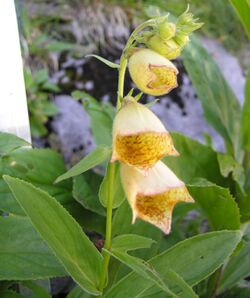Biology:Digitalis grandiflora
| Digitalis grandiflora | |
|---|---|

| |
| Digitalis grandiflora at Schynige Platte | |
| Scientific classification | |
| Kingdom: | Plantae |
| Clade: | Tracheophytes |
| Clade: | Angiosperms |
| Clade: | Eudicots |
| Clade: | Asterids |
| Order: | Lamiales |
| Family: | Plantaginaceae |
| Genus: | Digitalis |
| Species: | D. grandiflora
|
| Binomial name | |
| Digitalis grandiflora Mill.
| |
Digitalis grandiflora, the yellow foxglove,[1][2] big-flowered foxglove, or large yellow foxglove, is a species of flowering plant in the genus Digitalis, family Plantaginaceae (formerly Scrophulariaceae). It is native to southern Europe and Asia. In mountains it grows on warm, bushy slopes or areas left after logging. The Latin specific epithet grandiflora means “large flowered”.[3]
Description
It is a herbaceous perennial growing from a short rootstock with fibrous roots.[4] D. grandiflora has glossy green, veined leaves, whose flowering stem can reach a height of 70–120 cm (28–47 in). The pale yellow bell-shaped flowers are spaced out on the stem, 3–4 cm (1–2 in) long and show a netted brown marking in their interior.[5] In the wild plants bloom in June and July.[6]
Cultivation
Digitalis grandiflora is long lived perennial,[6] it has gained the Royal Horticultural Society's Award of Garden Merit.[7][8] It is winter hardy is USDA zones 3 to 8 and grows best in moisture retentive, but well drained, organic soils in part shade.[9] Cultivated plants in Germany bloom from June to August, in North America, flowering occurs from May to June in Missouri and from June to July in Ohio; with the typical bloom period lasting eight weeks.[6]
Cultivars
Hybrids
- Digitalis × fulva, Lindl. 1821
(Hybrid formula: Digitalis grandiflora Mill. × Digitalis purpurea L.).
Pharmacology
As the plant contains cardenolides, all parts are toxic. Its leaves contain 0.2% glycosides of the digitoxin-type and about 0,1% of the digoxin-type. Even so, the plant is not used in the production of cardiac glycosides.
Gallery
-
plant
-
flowers
-
fruits
References
- ↑ (xls) BSBI List 2007, Botanical Society of Britain and Ireland, https://bsbi.org/download/3542/, retrieved 2014-10-17
- ↑ "Digitalis grandiflora". Natural Resources Conservation Service PLANTS Database. USDA. https://plants.usda.gov/core/profile?symbol=DIGR4. Retrieved 18 January 2016.
- ↑ Harrison, Lorraine (2012). RHS Latin for Gardeners. United Kingdom: Mitchell Beazley. ISBN 978-1845337315.
- ↑ Flora of the U.S.S.R.. 22. 1997. https://www.biodiversitylibrary.org/page/29991325#page/501/mode/1up.
- ↑ RHS A-Z encyclopedia of garden plants. United Kingdom: Dorling Kindersley. 2008. pp. 1136. ISBN 978-1405332965.
- ↑ 6.0 6.1 6.2 6.3 6.4 Tomasz Ani_ko (1 January 2008). When Perennials Bloom: An Almanac for Planning and Planting. Timber Press. pp. 173–. ISBN 978-0-88192-887-7. https://books.google.com/books?id=ODYpMZXFnSQC&pg=PA173.
- ↑ "Digitalis grandiflora". https://www.rhs.org.uk/Plants/5856/Digitalis-grandiflora/Details. Retrieved 27 May 2020.
- ↑ "AGM Plants - Ornamental". Royal Horticultural Society. July 2017. p. 29. https://www.rhs.org.uk/plants/pdfs/agm-lists/agm-ornamentals.pdf. Retrieved 6 February 2018.
- ↑ "Digitalis grandiflora - Plant Finder". http://www.missouribotanicalgarden.org/PlantFinder/PlantFinderDetails.aspx?kempercode=c628.
| Wikimedia Commons has media related to Digitalis grandiflora. |
Wikidata ☰ Q157085 entry
 |



